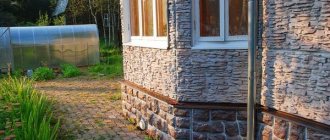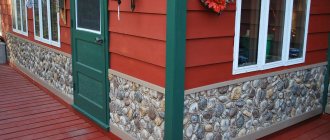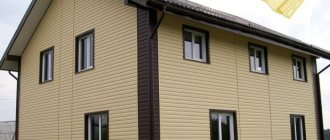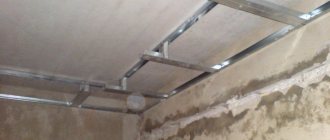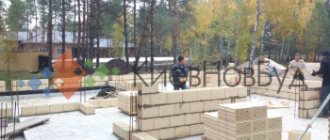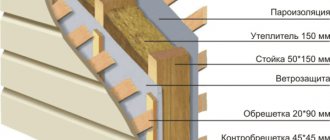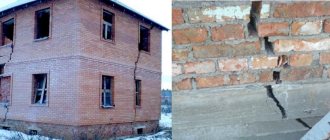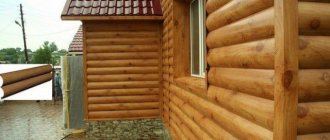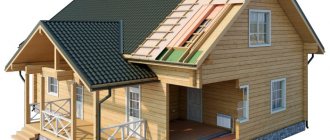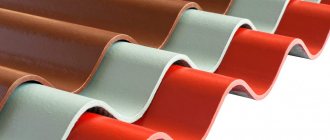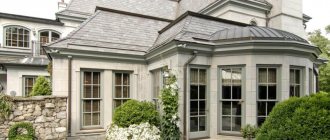Design features of facade systems
All types of facade finishing can be divided into two groups:
- thermal insulation – multilayer systems based on insulation, designed to minimize heat loss, increase energy efficiency and decorativeness of the building;
- protective and decorative - multi-layer systems or single-layer materials to protect the building envelope from external factors and increase the attractiveness of the house.
Both thermal insulation and protective and decorative facades come in two types:
- wet - the device technology involves the use of construction and finishing mixtures (masonry mortar, adhesive mixtures, rough plaster, decorative plaster);
- hinged - fixation of system elements is carried out mechanically, in a dry way, using subsystems (lathing, counter-lattice) and hardware (screws, dowels, clamps).
Curtain facades with thermal insulation are always ventilated - air circulation from bottom to top is necessary to maintain the insulation in a dry state. If we are talking about a hinged protective and decorative facade, a ventilation gap is not needed; the cladding is attached either directly to the base or to a subsystem.
Lining, block house and other wood materials
Lining or carriage board is a thin cladding board made from natural wood. This material is considered the most environmentally friendly option for cladding private and other types of buildings. For connoisseurs of naturalness and authenticity, it is necessary to take into account not only the advantages of this material, but also its disadvantages.
Advantages of wood materials:
- the lightness of such facing coatings allows you to save money when designing and pouring the foundations of buildings;
- due to the natural nature of the wood, it does not contain any admixture of toxic substances;
- the walls of the house can breathe and do not accumulate condensation, preventing the appearance of mold and fungal formations;
- has excellent heat-protective and noise-absorbing properties;
- can be easily painted, which is necessary to give the facade of the house any color shades and various design solutions.
Disadvantages of lining for exterior finishing:
- has high flammability, like other lumber;
- accumulates excess moisture, quickly becomes damp and collapses;
- has a high number of natural structural defects;
- easily deteriorates under the influence of external factors and insects.
Yes, indeed, lining is considered the cheapest solution for exterior cladding of a house. However, serious disadvantages inherent to wood do not allow its use for a long period. To give wood better performance characteristics, various special compounds are used that are applied to the surface of the material (antiseptics, impregnations, stains and varnishes) to prevent rotting and destruction. Most often, lining and block house (wood siding to look like logs) are used for finishing wooden buildings.
The cost of this material is at an affordable level. On average, you can purchase a block house from a Ukrainian or Russian manufacturer in the range of 350-700 rubles per square meter. And the cost of lining for external work ranges from 400 to 1000 rubles.
When giving preference to imported materials, of course, you need to be prepared for a higher price. Speaking about how cheaper it is to sheathe the outside of a wooden house, it is worth considering other budget options. The methods presented below are suitable for buildings made of various materials (brick, concrete and other building materials).
Types of facade finishing
Houses of the previous generation could not boast of a wide variety of facades - red brick cladding (ceramics), white brick cladding (silicate), cement-sand plaster coat, paint (panel and wooden houses). Considering that they were built primarily from brick, panels and logs, there was no particular need for other finishing options. With the advent of frame technology and various large-format blocks aimed at mandatory finishing, demand has increased and supply has appeared. The classics have not gone away, both brick and wooden housing construction are at their peak, but several spectacular and effective ways to protect and transform buildings have been added. It is problematic to list all the possible options for decorative finishing of the facade of a house; something original always appears, so let’s look at the most popular ones.
- Siding.
- Facade panels.
- Wood cladding.
- Decorative plaster.
- Brick cladding.
- Tiles on the facade.
- Stone cladding.
Siding
This category unites a large group of materials for facade cladding with common characteristic features:
- long typesetting panels imitating a wooden board or log;
- fixation of type-setting elements with hardware to a wooden, metal or polymer subsystem (curtain façade);
- high decorativeness - the cladding does not require additional manipulations; after assembly, a completed facade is obtained without the need for treatment with protective and decorative compounds.
Modern siding comes in several varieties.
Vinyl
Produced from polyvinyl chloride (PVC) using the extrusion method, previously the material was characterized by low color fastness and fragility. Today's polymers have improved significantly technically; even in dark collections, the color saturation remains for years, and the resistance to mechanical stress is an order of magnitude higher. In addition to regular vinyl siding, manufacturers offer foam siding, which is thicker, stronger and more durable. Both vinyl and foam siding have a number of advantages.
- Presentable – a large selection of textures and colors, a fairly high level of imitation, thanks to the textured surface.
- Durability - the polymer is resistant to temperature, moisture, and is not subject to corrosion.
- Versatility - due to its low weight and installation method, it can be used on almost any type of base, both with and without insulation.
- Ease of installation - assembly of the subsystem and the cladding itself does not require expensive equipment and professional skills; you can do it yourself. Due to the absence of wet processes, facade finishing with siding is carried out almost all year round.
Three times DadForumHouse Member
Vinyl siding, herringbone, blueberry, the facade was made by myself, on a wooden block.
The disadvantages of siding are largely related to its quality - budget cladding can fade, crack in the cold, and can warp and warp due to severe overheating. Not everyone likes the appearance of siding, but this is purely a matter of taste and financial capabilities; the original is always cooler than the imitation, but also more expensive.
Metal
Corrosion-resistant aluminum siding is the prerogative of public buildings; in the private sphere it is used in combined facades, in fragments. As the main cladding, steel siding with a polymer protective and decorative coating is in demand. Metal also imitates natural wood, most often it is a board, beam, block house or log, but only in profile and pattern, and not in texture. The advantages of metal siding include durability with decorativeness, and versatility with ease of installation. Plus, the metal is not afraid of mechanical stress, does not burn or crack in the cold, and even exceeds its vinyl counterparts in terms of service life.
viktor5000FORUMHOUSE Member
I started decorating at the beginning of winter, half of the house is ready. I’m posting photos for variety, otherwise when I was looking for options, there were few samples on the Internet. Metal is absolutely everywhere: the roof, walls, soffits and trim on windows and doors. There is not a single plastic part.
But damage to the protective layer during installation or operation is fraught with the appearance of corrosion, and rust does not paint any façade. During the work, extreme care must be taken so as not to block all the advantages of the material by careless installation.
Fiber cement
It is made from a mixture of cement binder and reinforcing fiber (fiber, mainly cellulose, but other inclusions are possible) by autoclave hardening. The production cycle allows us to obtain a surface that is as close as possible to wood in texture. The installation technology is standard, usually a wooden or metal subsystem; extensions can be either special or homemade. Fiber cement on the facade is combined with natural wood, stone and plaster. The strength, durability and wear resistance of fiber cement boards is higher than that of vinyl, while metal is inferior in reliability, but this type of siding is the most expensive in terms of cost. The relatively large mass (15-18 m²) is not a drawback; any foundation, be it a monolith, masonry or wooden frame, can withstand such weight. Installation of fiber cement cladding is somewhat more complicated, since the boards are only single and cutting is more labor-intensive, but it is also quite possible to carry out all the manipulations on your own.
Ilya1005FORUMHOUSE Member
The house was covered with fiber cement siding; the workers liked the material. For those who are just going to do this: don’t use branded paint for the ends, you can tint acrylic water-dispersed paint in the desired color, it will be a lot cheaper. Self-tapping screws are also excellent in the hypermarket (800 rubles for 500 pcs.) The manufacturing company has self-tapping screws for 3,200 rubles for 500. You can save a little.
Options for external finishing of the plinth
The lower part of the house—the basement or ground floor—often stands out from the rest of the building. This part of the building structure performs a load-bearing function, and thereby ensures the reliability of the building. Therefore, the base itself must be effectively protected from external influences - primarily moisture and temperature changes. In addition, the decoration of the basement, as a rule, contrasts with the cladding of the walls - which, oddly enough, gives the building a neat, solid, finished look.
Main functions of the plinth:
- protection of the building foundation from moisture and water;
- thermal insulation, reduction of heat loss;
- mechanical protection;
- aesthetic function.
As you can see, the choice of finishing for the base is of great importance - for the entire building as a whole. The reliability and durability of the home, as well as the comfort of residents and users, depend on the type of material and quality of installation.
How to choose the right material for finishing the base
First of all, you need to consider what type of base you plan to finish. Its surface can be flush (in the same plane) with the wall of the building, or protrude forward (protruding option), or recess inward (recessed option).
The classic protruding base looks presentable, but needs careful sealing - protection from moisture. The same applies to the base, made flush with the walls. In these cases, finishing is more difficult and more expensive. But the sinking base is better protected from water, so its finishing is simpler and cheaper.
When choosing a cladding material, you should take into account the height of the base part. It should be at least 40 cm. In high-rise buildings, an entire basement floor is usually equipped - it is allocated for offices and shops, and is tiled accordingly.
It is necessary to take into account the type of foundation, the presence and nature of the operation of the basement. In buildings on a strip foundation, a warm basement is most often installed, which requires additional thermal insulation. If the house is built on a pile-screw foundation, enhanced thermal protection from the ground is not required, and the base in this case does not perform a load-bearing function.
The material for cladding the base must have increased mechanical strength - since the lower part of the house is most susceptible to various types of shocks and impacts from people and equipment. Equally important is high resistance to fungus, insects and rodents.
Types of materials for finishing the base
Taking into account the above factors, the following finishing materials are most suitable for cladding the basement of a building:
- clinker or composite tiles;
- natural or artificial stone;
- facing brick;
- decorative plaster;
- fiber cement panels;
- metal siding.
External cladding must be used in combination with insulating materials. Waterproofing is especially important for the base, so the building base is finished with materials that provide complete protection from moisture (for example, bitumen coating or penetrating insulation).
If the facing material is attached directly to the walls with glue, a primer is used to improve adhesion. Primers are also used for plastering (for each layer of plaster). They enhance the adhesion of materials and increase the durability of the finish.
You can find out prices and buy primer here.
Panel materials are mounted using a frame system. It is best to use a more reliable metal profile. The space inside the frame is filled with insulation.
A modern alternative to an insulated frame is cladding with thermal panels. Sandwich panels containing insulation are attached with glue close to the base. They look no worse than clinker tiles and provide the necessary thermal protection.
Facade panels
Initially produced specifically for the base, they are characterized by increased strength and resistance to all types of influences, from atmospheric to mechanical. If the siding imitates wood, both in shape and appearance, then the panels repeat fragments of brick or stone cladding; there are also collections for a plaster facade, but less often. The surface can be either smooth, like facing ceramic bricks, or textured, like hand-molded bricks and various types of stone. Panels, like siding, are of several types.
- Polymer - apart from the type, they differ from vinyl siding in greater thickness.
- Fiber cement - the only difference is in shape and texture.
DusyaChashkinaFORUMHOUSE participant
The facade is finished with panels - Japanese, fiber cement, metal subsystem, expensive, but beautiful. All that remains is to finish the blind area. I'm happy with the result!
It is worth considering thermal panels separately, since this relatively new material for facade finishing is both insulation and decorative screen. Unlike polymer and fiber cement panels, thermal panels are fixed directly to the base with glue (adhesive foam) and mechanically, without a subsystem. The thermal insulation layer can be polystyrene foam (EPS), extruded polystyrene foam (EPS, XPS) or polyurethane foam (PPU). The front decorative part is usually made of clinker or ceramic tiles, printed concrete or flexible stone (a combination of acrylic polymer and quartz sand or marble chips).
Vyacheslav715FORUMHOUSE Member
A frame house (OSB exterior cladding) was lined with thermal panels made of polystyrene foam (60 mm) with German clinker tiles in 2003. There are no defects in the facade. It hasn’t been opened, but there are no signs of damage (odor, mold, etc.) in the house, photo – winter 2021.
Review of costs for different types of materials for exterior home decoration
The cost of façade cladding depends on:
- house size;
- type of material selected;
- whether insulation is used or not;
- The work will be carried out with your own hands or by professional craftsmen.
When choosing a material for finishing the facade, keep in mind that some have a price per square meter, others per piece, and still others per kilogram. Therefore, recalculate to one denominator and then make your choice.
In this table, prices are indicated from the minimum, and the range may increase depending on the manufacturer and composition.
| Type of cladding | Price | |
| brick | clinker | 16 rubles per piece |
| ceramic | 25–35 rubles per piece | |
| hyper-pressed | from 19 rubles per piece | |
| silicate | 13 rubles per piece | |
| stone | natural | from 1300 rub/m2 |
| artificial | from 1000 rub/m2 | |
| plaster | mineral | from 317 rubles for 25 kg |
| acrylic | from 350 rubles for 25 kg | |
| silicone | 1450 rub for 25 kg | |
| silicate | 6360 rub for 25 kg | |
| porcelain stoneware | from 480 rubles per slab | |
| concrete tiles | from 450 rub/m2 | |
| ceramic facade tiles | from 750 rub/m2 | |
| siding | from 220 rub/m2 | |
| sandwich panels | from 1200 rub/m2 | |
| facade cassettes | from 550 rub/m2 | |
| thermal panels | from 1500 rub/m2 |
Wood cladding
Wooden cladding is classified as siding, which is not entirely correct - siding is an imitation of wood, not a natural finish. The most common are several types of wood cladding.
- Board - both planed and unplaned boards are used, the orientation is predominantly horizontal butt-joint or overlapped (American), but vertical cladding based on Scandinavian motifs is also found.
- Planken - usually made of larch, a perfectly smooth board with hewn edges and edges, is rarely used as the main material due to its high cost, and is mainly combined with other types of facade finishing.
- Lining is the most common interior wooden finish, but it is also widely used on the facade, the difference is in the type of wood (coniferous is desirable for the street) and thickness (15-25 mm). The lining is a dry, profiled board planed on all sides with a tongue-and-groove system, just like siding.
- Imitation of timber - most often made from coniferous wood, like lining, this type of board has a tongue-and-groove system, plus side chamfers cut at an angle of 40˚. It is used for both interior and exterior decoration, the only difference being the thickness of the planks (20-40 mm). After installation, the facade is indistinguishable from the facade of a house assembled from real profiled timber.
- Block house is also an imitation, mainly external, but not of timber, but of logs, the difference from lining and imitation timber is only in the semi-cylindrical profile shape. From afar, the façade of a block house is indistinguishable from a log house; up close, the ideal geometry and uniform size will be noticeable, which is uncharacteristic even for a rounded log, not to mention a hand-cut one.
- Shingles - unlike the bulk of wood trim, this is small-piece cladding in the form of plates, 5-10 mm thick, up to 400 mm long and 150-20 mm wide. The name of the material is due to the manufacturing method - they “tear” the chock, breaking off dies from it.
Regardless of the type, wooden cladding is attached to the sheathing and hardware (nails, clamps, etc.). The most popular is wood cladding of frames and wooden houses after insulation, but the base can be almost anything. The advantages of natural cladding include:
- Environmentally friendly.
- Decorative.
- Easy to install.
- Resistant to temperature changes and mechanical stress.
The main disadvantages are the relatively short service life, high cost and the need for additional protective and decorative treatment. And such treatment must be repeated every few years, the specific interval depends on the type and quality of the chosen product. Covering paints stay on the facade longer than glazing compounds and impregnations, but not everyone wants to hide the original texture.
Zack75FORUMHOUSE Member
Chopped larch shingles of decent quality and geometry, the dies were attached to the sheathing with special nails with a D-shaped head and a nailer. This is what ended up happening. Bast hut!
I think the idea with rounded corners is especially cool. By the way, it’s easier to match the walls this way. Somehow I didn’t quite understand how to make the outer corners of the shingles, otherwise it would have been difficult and less interesting, IMHO.
Finishing with natural or artificial stone
Where is it used?
Decorative cladding of the base with stone is most often used in country houses and office buildings. Less commonly, this material is used to finish the entire facade. It is suitable for use in any climate zone. The stone is resistant to temperature changes and moisture.
Artificial and natural stones are used to decorate the facade:
- Fake diamond. Manufacturers produce several types of artificial stone: clinker, concrete, sand-polymer, ceramic. The materials differ in appearance and properties.
- A natural stone. The most commonly used stones are granite, marble, travertine, slate, tuff, sandstone, and dolomite.
Artificial stone made from a sand-polymer mixture. In appearance it is very similar to the real one (photo No. 9)
pros
- Natural and artificial stone is strong, moisture-resistant and durable. If installed correctly, the facade does not require additional maintenance for ten years.
- A façade finished with natural stone looks solid and expensive.
Minuses
- Natural stone is difficult to cut. The hardest thing to work with is granite and marble.
- If low-quality dyes are used in the production of artificial stone, the stone will fade. It is difficult for an ordinary buyer to determine how high-quality the product is.
- The cost of natural stone is 2-15 times higher than other finishing materials.
Decorative plaster
Wet facade, mainly within the framework of composite insulation systems, although decorative plaster can also be applied to a prepared base without a layer of thermal insulation. In SFTK (facade thermal insulation composite system) the “pie” is standard.
- Insulation – expanded polystyrene (PSB), stone wool slabs, mineral wool slabs (high density).
- The reinforcing layer is an adhesive composition with a fiberglass mesh embedded in it; it is also called the base or anti-vandal layer.
- Decorative plaster - applied using various techniques, depending on the type of plaster mixture, the texture is expressed with a “pattern”, or homogeneous with a slight relief. After application, the facade is primed and painted.
The popularity of finishing facades with plaster in the private sector is explained by a number of advantages.
- Increasing the energy efficiency of buildings at any stage of finishing - both during construction and after several seasons.
- Highly decorative - a lot of design options, various patterns and a wide range of colors, the ability to change the architecture and proportions (visually) through applied decor (homemade or factory moldings).
- Wear resistance – resistance to both temperature fluctuations, moisture, and mechanical stress.
- Durability - the original appearance of a wet facade can be preserved for decades; painting is enough to update it.
- Ease of execution - if desired, almost anyone can learn how to “twist a bark beetle,” and the level of skill does not always depend on experience.
However, all of the above advantages “work” only if the type and thickness of insulation is correctly selected, the quality of all system materials is good, and the technological process is followed. The fragility, staining, peeling and cracking of plaster attributed to this type of finish are the result of violations of the stated conditions.
Initially, the finishing layer of the wet facade was only cement-based mineral plasters, with the addition of stone granulate of different fractions. And the most common type of pattern, bark beetle, also known as rain, is clear grooves formed by the vertical movement of granulate in the thickness of the plaster layer. Today there are more decorative plasters and patterns, there is plenty to choose from.
- Acrylic - the main difference between this type of plaster and mineral plaster is its high elasticity, which is especially important if movement of the base is possible. But acrylic compounds cannot be applied to bases made of stone or mineral wool slabs, since their vapor permeability is lower than that of these insulation materials.
- Silicone - in terms of wear resistance and durability, they are superior to both mineral and acrylic compositions; they practically do not absorb dirt, due to which dust from the facade is washed off during rain and the facade does not require maintenance.
If insulation of the facade is not planned, but the task is to decorate the surface, not only mineral, acrylic and silicone plasters are used, but also silicate ones. Despite such advantages as elasticity, vapor permeability and wear resistance, their disadvantages include “selective” adhesion. If the base is not silicate, but made from other materials, you will have to spend money on a specialized primer. Plus, silicate compounds are more difficult to apply, especially when large volumes need to be plastered. Without a certain level of preparation, a beautiful facade may not work.
SFTK with decorative plaster are universal; under certain conditions, even frame frames can be finished, and the non-static nature of the base does not become a hindrance.
Review of the modern façade materials market
All types of materials for external cladding can be divided into traditional and modern alternative materials. Traditional solutions include: wood, stone, brick, plaster. Among modern finishing materials: siding, thermal panels and combined solutions, such as a wet facade.
Let's take a closer look at what materials there are for the exterior decoration of a house, and then compare them and choose the best - the most reliable and practical, allowing you to stylishly decorate the building and effectively protect it from the outside. We will also make a rating of facade cladding materials that are popular in 2021.
Facade plaster
One of the most popular methods of cladding the facade of a building is plaster. In 2021, this exterior finishing option is still in demand due to its practicality and affordability. Plastering exterior walls can be done relatively quickly and inexpensively. For this purpose, plaster mixtures are used: they are quite easily applied to the surface to be finished, and after complete drying and hardening they form a durable layer that is resistant to moisture, atmospheric and mechanical influences.
Plaster allows you to perfectly level the walls. Most often, plaster materials are used for cladding block, concrete, and brick walls. It is also possible to plaster the wooden surface to protect the wood and provide additional insulation.
Tinting the plaster mixture makes it possible to cladding the facade in any color of interest. The material slightly weighs down the walls. However, it is extremely important to strictly follow the plaster application technology - deviation from it risks the formation of chips and cracks. Therefore, work should be trusted only to experienced plasterers.
When choosing facade plaster, it is important to understand what material it is made of - it may have a mineral, silicate, acrylic or silicone base.
Mineral facade plaster
The most widespread are mineral plasters based on cement and lime (often combined into one type - cement plasters). They are affordable and versatile in application - they can be used both for interior decoration and for facade cladding. Among the disadvantages: insufficient elasticity, not the highest adhesion, long drying time. Experience is required to work with this material. Hand or machine application possible.
You can find out prices and buy cement plaster here.
A type of mineral plaster is silicate plaster. It is made from potassium and sodium silicates obtained by melting glass. The material does not allow water to pass through, can withstand temperature changes and is characterized by increased adhesion to silicate surfaces, as well as to such types of insulation as mineral wool and polystyrene foam.
Acrylic plaster
Plaster based on synthetic acrylic resins is becoming increasingly widespread in the field of street finishing. They give the material increased elasticity and a more attractive appearance. Ready-made acrylic compositions are distinguished by a variety of colors, are quite easy to apply, dry quickly, and adhere well to any mineral surfaces. A façade finished with acrylic plaster is not susceptible to cracking, and its service life is approximately 2.5 times longer than that of mineral plaster.
Silicone plaster
Products based on silicone resins are the most expensive. Like acrylic, it is offered in ready-to-use form. Increased elasticity guarantees the absence of cracks on the facade. In addition, such plaster does not attract dust and dirt and is capable of “self-cleaning”. It has a long service life. And yet, the use of silicone plaster compositions is limited due to their high cost.
Decorative plasters
All types of plasters come in two types: leveling and decorative. Conventional leveling compounds provide an even, smooth surface. Decorative plasters contain a filler, which, when applied and smoothed, forms a specific pattern. The most popular decorative textures: bark beetle, lamb, fur coat. There are also stone and mosaic plasters.
Decorative plaster is suitable for finishing the facade of a residential building, a commercial building (office center, store), as well as a fence. The selected drawing allows you to focus on the architectural advantages of the building, distinguishing it from other structures.
You can find out prices and buy decorative plaster here.
Facing brick
A reliable option for insulating and cladding the facade is facing brick. They lay out an additional – external – wall of the house. It provides high wind and water protection, and also hides unsightly parts of the building structure. Brickwork doesn't come cheap - but it's a long-term investment. Brick is durable and does not require maintenance.
There are several types of facing bricks:
- ceramic - a budget solution based on red clay that has been molded and fired;
- clinker - a denser type of ceramic, characterized by increased strength and used for finishing plinths;
- hyperpressed - very durable decorative brick with a beautiful textured surface;
- silicate - another budget option, creates a significant load on the foundation and is afraid of moisture.
To insulate a building, porous or hollow bricks are used. It weighs less, thereby reducing the load on the foundation.
The front surface of ceramic bricks can be simple (smooth), textured or glazed. The material can be white or colored, as well as engobed (with an additional front layer painted in a certain color).
When calculating the cost of brickwork for cladding the outside of a house, the cost of masonry mixtures is included in the budget. Special masonry compounds provide strong adhesion between facade elements.
Clinker tiles and porcelain tiles
A more economical and lightweight alternative to clinker bricks is clinker tiles. It is made from the same material and is externally indistinguishable from brickwork.
The tiles can be laid on a base previously leveled with plaster or on a frame. In a frame system with guides, insulation is usually used - for example, mineral wool or polystyrene foam.
Porcelain stoneware slabs are used to install ventilated facades. They are more impressive in size and create a decent load on the foundation. They are mounted on a special facade profile, and insulation is placed under the slabs. Porcelain tiles reliably protect walls from wind and precipitation, and also look stylish - this is an excellent solution for a high-tech facade. They are most often used to clad office buildings and shops.
Installation is carried out using special adhesive for tiles and porcelain stoneware. You should also budget for grout for the joints.
You can find out prices for adhesives for tiles and porcelain tiles here.
Siding
The most economical facing material for the facade is siding. Covering walls with siding panels can be done relatively cheaply and quickly. Installation is carried out on a ventilated sheathing; insulation can be used if desired.
Siding is not the most reliable and durable material, but it is quite easy to install and does not require additional finishing. This type of cladding is often used for pavilions, various types of commercial facilities, as well as for residential buildings - frame and block. Imitation of wood or stone can look good on the facade of a private house.
What kind of siding is there:
- vinyl (plastic) - the cheapest;
- metal - made of galvanized steel with polymer coating;
- fiber cement (composite) - more expensive, with improved decorative properties.
There is wall siding and basement siding - for cladding the lower part of the building. You can choose panels that allow for both horizontal and vertical installation.
Tree
For a country house, wooden cladding of the facade may be suitable. The tree fits perfectly into the suburban landscape. However, this is a fancy material that requires high-quality finishing - impregnation, protective coating. Facade paints can be used for color painting. And if you want to preserve the natural wood grain, use special wood oils.
You can find out prices for paint for wooden facades here, and for wood oil here.
For the exterior decoration of the cottage, you can choose clapboard cladding - this is one of the budget options. To make the house look like wood, the outside walls are sheathed with imitation timber or logs (block house). Planken looks stylish - a modern type of cladding board without tongue-and-groove fastening.
When choosing wooden cladding, it is important to consider what material the board is made of - inexpensive pine or more reliable larch.
Facade cassettes
To create a ventilated facade, facade cassettes can be used. This is an economical alternative to porcelain stoneware. Instead of porcelain slabs, metal or composite sheets are used as cladding material in cassettes. Their main advantage is their relatively low weight. Therefore, they can be used for cladding a multi-story building.
Such waterproof and windproof facades are mounted on a system of metal profiles, usually in combination with insulation. This ensures the necessary insulation of the building. And due to the fact that the facing sheets can be painted in any color, you can safely experiment with the appearance of the construction project. The technology is used mainly for exterior decoration of commercial buildings.
Sandwich panels
Modern solutions for façade cladding combine the best properties of traditional and alternative materials. One of such successful solutions for home decoration are thermal panels.
The thermal panel is a kind of sandwich consisting of three layers. The inner layer is an adhesive base. Outside - composite material or clinker tiles imitating brickwork. Between them there is a layer of insulation - polyurethane foam or polystyrene foam.
Manufacturers claim that thermal panels reduce building heat loss by 20-40% and provide excellent sound insulation. And the service life of such facade finishing reaches 50 years.
Wet facade
Another combined technology of external cladding is the “wet facade”. It involves the use of the following combination of materials:
- insulation - a layer of thermal insulation;
- reinforcing facade mesh;
- plaster or slab material.
Polystyrene foam or mineral wool is used as insulation. Thermal insulation is attached to the load-bearing wall of the building, for which special facade dowels are used. A reinforcing mesh is placed directly on the insulation using an adhesive mixture. And plaster is applied to it - first the base layer, and then the decorative layer.
If a ventilated façade is installed, a façade profile is used. With its help, slab material - for example, porcelain stoneware - is attached to the load-bearing wall.
Brick cladding
Finishing the facade with brick is a classic that is always relevant if the price is not at the forefront. But the cladding is designed immediately, since the brick screen needs a solid foundation. When everything is according to plan, and not at once, free space is left on the foundation for facing bricks. Both walls run parallel, inside and out, using flexible ties or otherwise tied together. Based on the parameters of the wall material, the “pie” may include insulation (slab, backfill), or the masonry is carried out without thermal insulation. The presence or absence of a ventilation gap between the base and the cladding depends on the vapor permeability of the base. If it matches the materials, for example, when the box is made of rough brick or ceramic block, a ventazor is not needed. If the walls are made of aerated concrete, foam concrete, wood concrete, wood or other materials with high vapor permeability, a ventilation gap is required. Different types of bricks are used for cladding facades.
- Ceramic - mainly for facing, but masonry from backfill “a la Bavarian” is also possible.
- Clinker - ceramics, but with improved characteristics on all fronts, be it service life or presentation. The high price classifies the material as a premium finishing class.
- Silicate is an option for everyone, for dry regions.
- Hyper-pressed - does not allow water to pass through, surpasses even clinker in strength, has a lot of colors and textures, but is not widely used.
A brick facade, subject to the choice of high-quality bricks and masonry mortars, as well as adherence to technology, is a complete advantage.
- Durability.
- Strength.
- Reliability.
- Resistance to any atmospheric factors and mechanical influences.
- Presentability.
However, not everyone can cladding a house on their own, and invited “masters” often manage to make mistakes. Plus, the foundation must be designed for such weighting, because there are two boxes. Wetting of the facade, efflorescence, spalling and other “delights” are not shortcomings of brick facades, but poor quality bricks, increased salt content in masonry mortars, and disturbances during the masonry process.
AntonKananykhinFORUMHOUSE Member
I am sharing my experience of Bavarian masonry using domestically produced clinker bricks, maybe it will be useful to someone.
- It is impossible to choose a material in a store; you need to take brick samples (10 pieces), seam samples and go to the site to see how the masonry will look in natural light.
- To make it easier to match the color, it is advisable to take bricks from one firing batch.
- The geometry is far from ideal, closer to a boat shape, but this is not critical.
- Craftsmen will have to pay extra for laying clinker.
- Pallets usually contain more dark-colored bricks, which are best set aside and used in less visible areas.
Everything was fine; if you are a perfectionist and are willing to overpay considerably, it is better to pay attention to German clinker.
Tiles on the facade
A broad category that includes small-format and large-format tiles, used both as the main finish and in combination with other materials. Several types of facade tiles are most in demand.
- Concrete - produced in the form of large panels with a brick or natural stone texture, less often in the form of a single “stone”, mounted mainly on a subsystem (clamps, self-tapping screws). A large selection of textures, relatively simple installation, resistance to external influences and durability provide concrete tiles with stable popularity among private owners. Artificial stone for facade finishing, also a type of concrete tile.
- Ceramic (clinker) - when you want a facade made of clinker bricks, but the funds and skill are not enough, use clinker tiles, which have retained all the performance characteristics of the original and differ from it only in their smaller thickness. The method of fixation is adhesive, using specialized mixtures. Today, the finishing layer of clinker tiles is increasingly found on thermal panels and in thermal insulating composite facade systems.
- Porcelain tiles - there is no particular point in placing it in a separate category, since it is also a tile, only large and heavy, which is why it is mounted on a metal subsystem, like facade cassettes. In terms of strength and durability, porcelain stoneware is comparable to brick and stone, but this decoration of the facade of a private house is not particularly common. Porcelain tiles are much more suitable for cladding public buildings and high-rise buildings in modern business class residential complexes.
kisnikFORUMHOUSE Member
Aerated concrete house, insulation, concrete tiles with stone texture on a wooden subsystem. It was possible to do it yourself, quite easily, but there was neither time nor any particular desire to delve into and understand the material. That’s why I chose the turnkey option and I don’t regret it.
Features of external decoration of multi-storey buildings
High demands are placed on the appearance of modern high-rise buildings. Of no small importance from the point of view of marketing (sales of apartments in new buildings) and the architectural appearance of the city is the appearance of the building and how well it fits into the urban landscape.
As a rule, industrial climbers are attracted to the external cladding of a multi-storey building. If the number of floors allows, scaffolding is used. When choosing a finishing material, the features of the building structure, as well as climatic conditions, are taken into account.
Two main options for cladding multi-storey buildings:
- “Wet” technology - finishing using plaster mixtures.
- Ventilated systems.
Finishing multi-storey buildings with plaster
“Wet” technologies include all types of plastering of external walls. For this purpose, water-based solutions are used. Plaster can be mineral, silicate, acrylic or silicone.
Together with mineral or silicate plaster, insulation can be used - mineral wool (for example, Paroc stone wool). It is mounted with a reinforcing layer of facade mesh and plastered on the outside.
When finishing with silicone or acrylic plaster, polystyrene foam is used in slabs. The thickness of the foam varies from 50 to 150 mm, depending on climatic conditions and wall material.
For finishing cladding, decorative plaster with a textured structure - for example, lambskin - can be used. The outer plaster layer is applied to the base layer and tinted - in any color at the request of the customer. This allows you to accurately reproduce the architectural ideas laid down by the designers.
Ventilated facades of multi-storey buildings
High-rise residential buildings and shopping and office centers are often faced with modern finishing materials - waterproof and windproof panels. In this case, predominantly lightweight solutions are used to reduce the load on the building foundation. Installation is carried out using a metal frame, which is attached to the walls.
The air gap in ventilated systems protects the walls from moisture and fungus. Installing a layer of insulation with a windproof membrane provides additional insulation. And the external “screen” (panel material) allows you to decorate multi-story buildings in a modern style.
What materials are the panels in ventilated facades made of:
- aluminum panel;
- vinyl siding;
- composite material.
The panel material is excellent for arranging a facade in a high-tech style. Thanks to this, the building fits better into modern buildings. The panels go well with glazing, including panoramic.
The type of facing material is selected based on the permissible load on the foundation, requirements for the strength of the finish and appearance of the building, as well as the construction budget. The advantage of a metal facade is increased reliability. At the same time, vinyl siding is lighter and cheaper. Composite panels combine such qualities as strength and noble appearance, but are quite heavy and expensive.
Stone on the facade
Stone is a heavy type of cladding, which somewhat limits its use and complicates the installation technology. Natural stone cladding is made from the following rocks:
- Sandstone;
- Limestone;
- Slate;
- Granite;
- Quartzite;
- Gabbro;
- Marble.
A stone façade is characterized by low vapor permeability, which is associated both with the low vapor permeability of the stone itself and with the presence of an adhesive layer in the system as an additional vapor barrier. Because of this, houses made of aerated concrete blocks and similar materials cannot be faced with stone directly, only in a facade insulation system. If the region is cold, like Moscow and the like, the house will need insulation from any material. Under the stone decorative layer in the SFTK double reinforcement is made:
- a layer of glue is applied to the insulation;
- reinforced armored fiberglass mesh with a density of 320 g/m² is embedded in the glue;
- through the first base layer (mesh and glue) disc-shaped dowels with a metal nail are driven into the PSB at the rate of 10-12 pieces per m²;
- another layer of glue in which a fiberglass mesh with a density of 145-165 g/m² is embedded;
- tightening the glue (so that the mesh is completely covered with the adhesive mixture).
The stone is glued onto the dried base using specialized adhesive mixtures, after which the seams are rubbed. To protect the stone façade from moisture, which it readily absorbs, water repellents or stone varnish are used.
Finishing the façade of a house with stone is exclusive, which is physically impossible to replicate, but the labor intensity exceeds even brick cladding. However, once, having spent time, effort and considerable money, you can forget about the facade for decades; it is not afraid of either weather conditions or physical influences.
ShufanForumHouse Member
Dagestan stone (sandstone) behaves well on facades even in humid climates. Over time, over twenty years, it may darken; to avoid this, it is enough to use a good impregnation.
Conclusion
The market has a huge selection of facade materials for every taste and budget, if the budget is limited - siding, panels, plaster or tiles. If the financial side of the issue is not critical and there is an opportunity to spend money on materials and performers - a facade made of brick or natural stone. Regardless of the variety, the materials must be of high quality, and the technology must be followed without a “collective farm”. In cases of outright disregard for the instructions and recommendations of manufacturers, problems will arise with any façade.
On the topic, you can read about the most beautiful and unusual facades of the portal’s participants, as well as about the brick cladding of a house made of aerated concrete and timber. The video contains expert advice on how to choose a facade.
Subscribe to our Telegram channelExclusive posts every week
